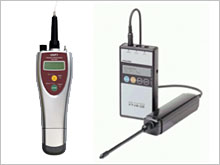Simplified VOC, etc. Measurement Technology field
Outline of Technologies
In general, the term “VOC” means causative substances which produce photochemical oxidants and suspended particulate matters (SPM) through photochemical and physical reactions. When the term “VOC, etc.” is used, it includes, for example, “TVOC in gas emissions”, “VOC in the indoor environment” and “odor”. Accordingly, technologies in a wider range are included in the target technology field.
Examples of Target Technologies
Reference Materials
- Protocol (Version 6: revised on July
18, 2014) [PDF/405 KB]
A protocol defines the basic approach for the implementation of verification tests, test conditions, test methods and other relevant matters in the relevant technology field.
- PR materials for simplified VOC, etc. measurement technologies in various foreign languages
If business operators emitting VOC, etc. obtain accurate data on the emission amount of VOC, etc. through day-to-day management and adopt optimal VOC, etc. emission reduction measures, positive effects can be expected. These effects include further improvement of the working environment, reduced cost of solvents and fulfillment of CRS through the increased transparency of environmental data. Meanwhile, even though many different simplified measuring instruments are available for use for voluntary measures, the existing data on the accuracy, operability, measurement cost and other relevant matters of these instruments is only that published by their manufacturers.
The ETV Program assists the selection of technologies suitable for the needs of users by means of disclosing the results of technology verification tests conducted by third party organizations and providing various types of information required to judge the effectiveness of individual technologies.
A questionnaire survey with verification applicants in the past received such replies as “The number of enquiries about the technology has increased since verification” and “There have been certain positive effects on sales promotion and technological development activities”. Another reply concerning the issued logo was that “The logo has been attached to the product pamphlet, technical reports, company brochure, and company website”.


















 Examples
of Technologies: Handy VOC sensor/monitor, etc.
Examples
of Technologies: Handy VOC sensor/monitor, etc.
